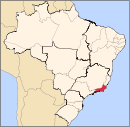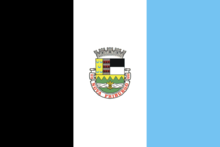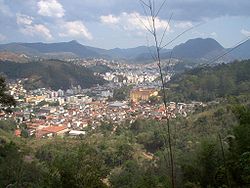- Nova Friburgo
-
Nova Friburgo (Portuguese pronunciation: [ˈnɔvɐ ˈfɾibuχˈgu] English: New Fribourg) is a municipality in the state of Rio de Janeiro in southeastern Brazil. It is located in the northern mountainous region of the state, 136 km from its capital Rio de Janeiro (city). The town is 846m (2,776 feet) above sea level and encompasses a total area of 938.5 km² (362.4 mi²).
Commonly referred to as just "Friburgo", the town has an estimated population of 178,102 people, known as "Friburguenses". It was settled by 2,006 Swiss emigrants from the canton of Fribourg, transferred to the region by royal decree from D. João VI in 1818, and was also the first town in the country to be settled by Germans. It contains the districts of Riograndina, Campo do Coelho, Amparo, Conselheiro Paulino, Lumiar and São Pedro da Serra.
Contents
History
On 16 May 1818, Prince Regent John VI of Portugal issued a decree allowing the Swiss representative of the Canton of Fribourg, Sebastian Nicolau Gachet, to establish a colony in Cantagalo. The purpose of this was to further encourage development within the Kingdom of Brazil and the area was chosen as it greatly resembled Swiss climate and geographical features. 100 Swiss families were to settle in the Fazenda do Morro Queimado (Farm of the Burnt Hill) where the colony of Nova Friburgo was later founded. From 1819-1820 a total of 261 families formed the original settlement nucleus and on the 17 April 1820 the government elevated its status to that of a village.
Following the Proclamation of Brazil’s Independence (1822) the Imperial Government continued a policy of populating the nation by attracting European colonisation. 80 German families led by Pastor Frederick Sauerbronn, previously assigned to settlements in the Province of Bahia, ended up in Nova Friburgo on the 3rd and 4 May 1824 and were warmly welcomed. Similar arrivals of Italians, Portuguese and a minority of Syrians led to such population increases that the once village was elevated to city status on 8 January 1890.
Agriculture was the basis of economic activity until 1910. The arrival of industrialists such as Julius Arp, Maximilian Falck e William Peacock Denis pioneered the development of an industrial sector still thriving to the present day. Of similar importance was the settlement’s relative proximity to Niteroi and Rio de Janeiro and improvement of transport and communication links such as the paved roads and telegraphs. This encouraged a small tourist industry to grow which, together with local commerce, became the main source of income for Friburguenses.
Nova Friburgo was affected by the 2011 Brazilian floodsJanuary 11th, with mudslides causing at least 820 deaths,and more than 200 people missing.The biggest natural disaster in the history of Brazil.The city was devastaded by a Damflood and the population was left with no water, electricity, food or gas. [1][2]
Demographics
- Total Population: 178,102 people
- Urban: 151,820
- Rural: 21, 501
- Male: 84,248
- Female: 89,073
The population density is 182.56/km² (472.8/mi²).
Schools
- Colégio Anchieta
- Colégio Estadual Canadá
- Colégio Modelo
- Colégio Nossa Senhora das Dores
- Colégio Nossa Senhora das Graças
- Colégio Nossa Senhora das Mercês
- Escola Fribourg
- Externato Santa Ignez
Universities
- Faculdade de Filosofia Santa Dorotéia - FFSD
- Universidade Candido Mendes - UCAM
- Universidade do Estado do Rio de Janeiro - UERJ (Polytechnic Institute - IPRJ)
- Universidade Estácio de Sá - UNESA
- Universidade Federal Fluminense - UFF (previously Faculdade de Odontologia de Nova Friburgo - FONF)
- Universidade Norte do Paraná - UNOPAR
Economy and industry
The city's per capita GDP was of $10.853,00 in 2006.
- Manufacturing/wholesale/retail of female underwear and lingerie. Friburgo is known as the 'National Capital of Lingerie' for the size and variety of its production(around R$600 million). Local brands are beginning to compete in the international market (exports worth $4.6 million)
- Textile mills
- Metallurgic industries
- Tourism
- Floriculture (second largest producer of flowers in Brazil).
- Service sector, responsible for the majority of the city's GDP.
Tourism
- The region presents a well diversified combination of historical sites reflecting the colonization by Swiss and German immigrants. This coexists with mountains and Atlantic rainforest.
- On the way to Nova Friburgo through RJ-116 road, your first contact with the people and with the characteristics of this city happens when you pass by Mury, an area that precedes by 7 km the downtown part of Friburgo. Mury plays the role of a welcome mat as it introduces to the visitor a first contact with the alpine architecture and environment, under the influence of the immigrants and present on many houses,hotels and stores, such as Hotels Bucksy, Garlipp and also at a small shopping center called Mury Shopping,which also happens to house the German restaurant which serves the largest quantity of beers available in Brazil- Bräun & Bräun - a perfect recreation of a Swiss-German environment .
Mury became a sophisticated center for gastronomy in the region and offers the best German style food, Swiss raclettes, fondues, and Brazilian style barbecues. Also Mury has the best hand craft stores, and underwear (lingerie), a trade mark of all this region.
Moving forward, a detour to RJ 142 provides access to Lumiar and São Pedro da Serra.
- To facilitate moving around in the area, it is convenient to obtain information locally on the so-called regional Circuits which serve as a guide to different visiting/eating/shopping alternatives.
- In the heart of the most protected environment area, is Macae de Cima forest. Beautiful mountains and gorgeous views of the Serra do Mar (Sea Mountains Chain), is an invitation to enjoy the Atlantic Forest in its natural status.As the second biggest forest area in the Rio de Janeiro state, in Macae de Cima we find the best nature expression.Also we can see the Macae River, rising in the forest and going to the sea, very far away, on the Rio de Janeiro coast.
- The rural life of Ponte Branca - walk on the rural properties, visit the trout tanks, animals and plantations; go fishing on beautiful rivers, or riding a horse;Everything according rules of International Institute of Popular Sports ( IVV/IRCODE)
- In the heart of the Macae de Cima Reservation, a part of the Atlantic Forest, you will find the ideal landscape for walking, adventures, sports.
- The Cão Sentado (a stone shaped as a seated dog) then, from the high level of those 1.111 meters, you will be able to see the yellow, green, blue and red flowers of the trees and plants which belong to this region.
- Located on the mountains of Macae de Cima Forest (environment protected area), are the cities of Mury, Lumiar and Sao Pedro. Distant only four km from each other, and only minutes from Nova Friburgo, these cities offer you many attractions as waterfalls, valleys and mountains. During the day, walking, hiking, canoeing, horse riding through the rivers, valleys, ponds, and rivers beaches; at night the charming presence of restaurants, and small shops, inviting you to a relaxing amusement.Sao Pedro city offers you also valleys and mountains. By car or bus, from the bus terminal of Nova Friburgo, go to direction the cities of Lumiar and São Pedro da Serra, 35 km far from the center of Nova Friburgo.
- Lumiar and São Pedro da Serra are located in the forest of Rio de Janeiro, around 700 meters high. Weather is very nice in the summer, and intense cold in the winter. Near the forest of Macaé de Cima, where Mace river is born, cutting the area of Macaé. This river is responsible for the big amount of waterfalls in the region. The tranquility and peace of the veillages of Swiss colonizing, the nice weather ,forests and waterfalls, are the ingredients more attractives to take us to these two villages.
- This region began by immigrants occupation, of the Macae river shores. Lumiar was a farm owned by Portuguese Felipe de Roure, who named the village Lumiar in honor to his wife Michaella, place where she was born in Portugal. Lumiar center, park Marchon, places the old house of this family, today a commercial space.
In Lumiar there are stores restaurants, bars, delikatessen, live music, hand crafts stores, and the famous trout of the rivers. Next to the central park is the São Sebastian church, built 1901. São Pedro da Serra, distant 5 km from Lumiar hás its name because of D Pedro II emperor of Brazil. Simple design church, hosts the famous June party for Saint Sebastian, a famous event to the region.
- The João Heringer park, and the Rodrigues Alves street are the center of social life in São Pedro, where everything happens. The hand crafts done in the “ ateliês”, restaurants, bars, fondues and chocolates, besides the tranquility of the region attracts people from every place to these small villages.
Sports
- Friburguense Atlético Clube is the most famous football (soccer) club of the city. The team plays at Eduardo Guinle stadium.
Sister cities
 Fribourg, Switzerland
Fribourg, Switzerland
External links
- City's official website
- www.pegamais.com.br Region's Portal with News, Photos, Local Social Network, Events, Ads
References
- ^ "Death toll mounts from flooding in Rio de Janeiro state". BBC News (BBC). 12 January 2011. http://www.bbc.co.uk/news/world-latin-america-12171710. Retrieved 13 January 2011.
- ^ Tom Phillips (14 January 2011). "Brazil Landslides Death Toll Rises". The Guardian. http://www.guardian.co.uk/world/2011/jan/13/brazil-landslides-death-toll-rises1. Retrieved 14 January 2011.
Coordinates: 22°16′S 42°32′W / 22.267°S 42.533°W
 Municipalities of Rio de Janeiro
Municipalities of Rio de JaneiroCapital: Rio de Janeiro Mesoregion
BaixadasBacia de São JoãoLagos
Mesoregion
Centro FluminenseCantagalo-CordeiroNova FriburgoSanta Maria MadalenaTrês RiosMesoregion
Metropolitana do
Rio de JaneiroItaguaíMacacu-CaceribuMicroregion
Rio de JaneiroBelford Roxo · Duque de Caxias · Guapimirim · Itaboraí · Japeri · Magé · Maricá · Nilópolis · Niterói · Mesquita · Nova Iguaçu · Queimados · Rio de Janeiro · São Gonçalo · São João de Meriti · TanguáSerranaVassourasMesoregion
Noroeste FluminenseItaperunaSanto Antônio de PáduaMesoregion
Norte FluminenseCampos dos GoytacazesMacaéMesoregion
Sul FluminenseBaía da Ilha GrandeBarra do PiraíVale do Paraíba FluminenseBarra Mansa · Itatiaia · Pinheiral · Piraí · Porto Real · Quatis · Resende · Rio Claro · Volta RedondaCategories:- Municipalities of Brazil
- Populated places in Rio de Janeiro (state)
Wikimedia Foundation. 2010.



